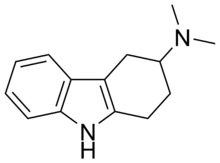Ciclindole
 | |
| Clinical data | |
|---|---|
| Routes of administration | Oral |
| ATC code | none |
| Legal status | |
| Legal status |
|
| Identifiers | |
| |
| CAS Number | 32211-97-5 |
| PubChem (CID) | 36082 |
| ChemSpider | 33189 |
| UNII |
CXJ7G6BYD7 |
| KEGG | D03619 |
| ChEMBL | CHEMBL2104160 |
| Chemical and physical data | |
| Formula | C14H18N2 |
| Molar mass | 214.31 g/mol |
| 3D model (Jmol) | Interactive image |
| |
Ciclindole (INN; WIN-27,147-2), also known as cyclindole (USAN), is an antipsychotic with a tricyclic structure that was never marketed.[1][2] It displaces spiperone binding in vitro and elevates dopamine levels in the striatum, indicating it acts as a D2 receptor antagonist.[2]
Synthesis

Cyclindole synthesis: Aram Mooradian; Sterling Drug Inc. U.S. Patent 3,959,309
See also
References
- ↑ David J. Triggle (1996). Dictionary of Pharmacological Agents. Boca Raton: Chapman & Hall/CRC. ISBN 0-412-46630-9.
- 1 2 Wood PL, McQuade PS (1984). "Ciclindole and flucindole: novel tetrahydrocarbazolamine neuroleptics". Progress in Neuro-psychopharmacology & Biological Psychiatry. 8 (4-6): 773–7. doi:10.1016/0278-5846(84)90057-5. PMID 6152347.
| Classes |
|
|---|---|
| Antidepressants (TCAs and TeCAs) |
|
| Antihistamines |
|
| Antipsychotics |
|
| Anticonvulsants | |
| Others |
|
This article is issued from Wikipedia - version of the 10/17/2016. The text is available under the Creative Commons Attribution/Share Alike but additional terms may apply for the media files.